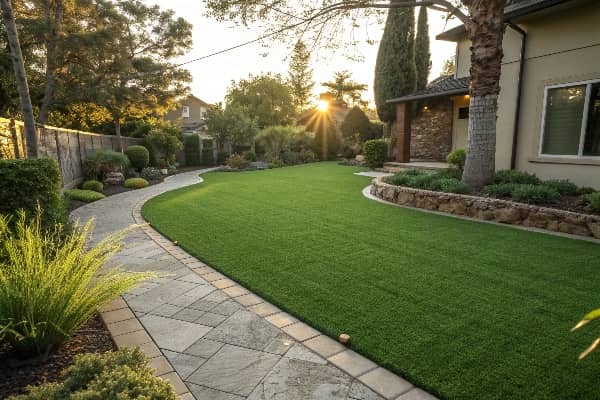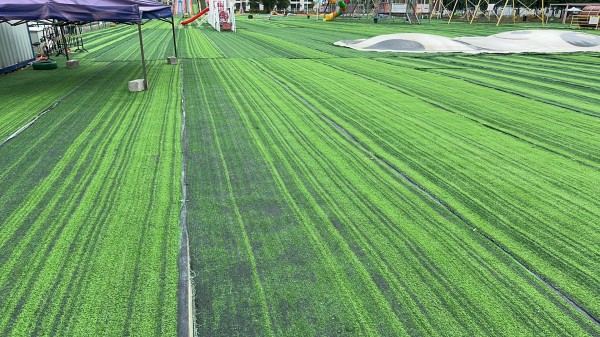Are you worried that your beautiful, green artificial lawn will turn dull and faded under the harsh sun? This is a common concern for anyone investing in a new lawn.
Yes, direct sunlight can affect synthetic turf, but modern, high-quality artificial grass is manufactured with UV inhibitors. These additives act like sunscreen for the grass fibers, preventing significant fading and keeping your lawn green and vibrant for many years, even in the sunniest climates.

I understand you want your investment to last. You need a lawn that looks great not just today, but for years to come. The thought of a faded lawn is a real fear, but the technology behind artificial turf has come a long way. Let’s look deeper into how sunlight affects the turf and what makes a product durable. This will help you choose wisely.
Does sunlight affect artificial grass?
You are spending good money on a new lawn and naturally worry that constant sun exposure will ruin it. It’s a valid concern that the sun could make it look fake.
Sunlight, specifically its ultraviolet (UV) radiation, can chemically damage artificial grass fibers. However, reputable manufacturers mix special UV inhibitors1 into the yarn during production. This process makes the turf highly resistant to sun damage, protecting its color and structural integrity for its entire lifespan.

From a scientific standpoint, UV radiation breaks down the molecular bonds in polymers, which is what plastic is made of. This can cause two main problems: color fading and the material becoming brittle. I have seen this happen with cheap plastics left outdoors. They lose their color and crack easily. The same principle applies to artificial grass. The solution is adding UV inhibitors directly into the raw materials before the grass fibers are even made. Think of it like sunscreen, but mixed into the material itself. I always tell my clients, like Mohammed in Saudi Arabia, to ask about the level of UV protection.
Here is a simple breakdown:
| UV Inhibitor Level | Typical Protection | Best For |
|---|---|---|
| 3% | Standard | Moderate sun exposure, temperate climates. |
| 5% | Enhanced | Strong sun exposure, hot climates. |
| 7% | Maximum | Extreme sun, desert climates like the Middle East. |
Adding more than 7% does not provide extra benefits. It is the maximum effective amount. Choosing a product with a high level of inhibitors is the key to a long-lasting, vibrant lawn.
How long does artificial turf last in the sun?
You want to know that your new lawn will last. Nobody wants to replace their turf after just a few years because the sun destroyed it. It’s all about getting value for your money.
A quality artificial turf with a high concentration of UV inhibitors can last from 8 to 15 years, even in very sunny locations. The exact lifespan depends on the quality of the raw materials and the amount of UV protection included during manufacturing.

The lifespan is not just about the color. It is also about the durability of the grass blades. Without proper UV protection, the sun will make the fibers brittle. They can then break with foot traffic, making the lawn look worn out. I remember a customer from a very sunny region, much like Saudi Arabia, who was extremely concerned about this. He needed turf for a large project and could not afford for it to fail. We supplied him with our top-grade product, which included a 7% UV inhibitor. He recently sent me a photo ten years after the installation. The color was still perfect. This shows a high-quality product is a safe investment.
Here is what you can generally expect:
| UV Inhibitor Level | Typical Warranty | Expected Lifespan (High Sun) |
|---|---|---|
| 3% | 5 Years | 5-8 Years |
| 5% | 8 Years | 8-12 Years |
| 7% | 10+ Years | 10-15 Years |
Of course, other factors like heavy foot traffic and proper maintenance also play a role. But when it comes to the sun, the UV protection is the most important factor for a long life.
Why are people getting rid of artificial grass?
You may have heard some negative stories online. People talk about removing their artificial grass, which can make you second-guess your decision. You might wonder if you are making a mistake.
People usually remove artificial grass for three main reasons: they chose a cheap, low-quality product2 that faded or fell apart, the installation was done poorly, or they have concerns about how hot the surface gets in direct sun without proper infill.

In my experience, the problem is rarely with the idea of artificial grass itself. The issue almost always comes down to the quality of the product or the installation. Let’s break down these concerns because understanding them helps you avoid them. First, a cheap product without UV protection will definitely fail. It will fade and become brittle, exactly like people worry about. This is why I always stress the importance of quality to buyers like Mohammed, who need to trust their suppliers. Second, a bad installation can ruin even the best turf. If seams are visible or the ground is not prepared correctly, the result will look awful. Finally, there’s the heat issue. Yes, artificial turf can get warmer than natural grass. But this is manageable. Using a light-colored sand infill3 helps a lot, and a quick spray with water can cool it down instantly.
Here are the problems and how to solve them:
| Problem | Common Cause | The Right Solution |
|---|---|---|
| Fading & Damage | Low-quality turf, no UV inhibitors. | Choose a quality product with a strong warranty. |
| Looks Bad | Poor installation, visible seams. | Hire an experienced, professional installer. |
| Gets Too Hot | Dark surface, no cooling infill. | Use light-colored sand infill and rinse with water. |
Conclusion
Modern, high-quality artificial turf resists fading because of advanced UV inhibitors. Choosing a quality-guaranteed product is the key to ensuring your lawn stays beautiful and green for many years.
-
Understanding UV inhibitors is crucial for selecting durable artificial grass that withstands sun exposure. ↩
-
Identifying low-quality products is crucial for ensuring durability and satisfaction with your artificial grass. ↩
-
Discover how light-colored sand infill can help manage heat and improve the performance of your artificial turf. ↩
_画板-1.png)
_画板-1.png)